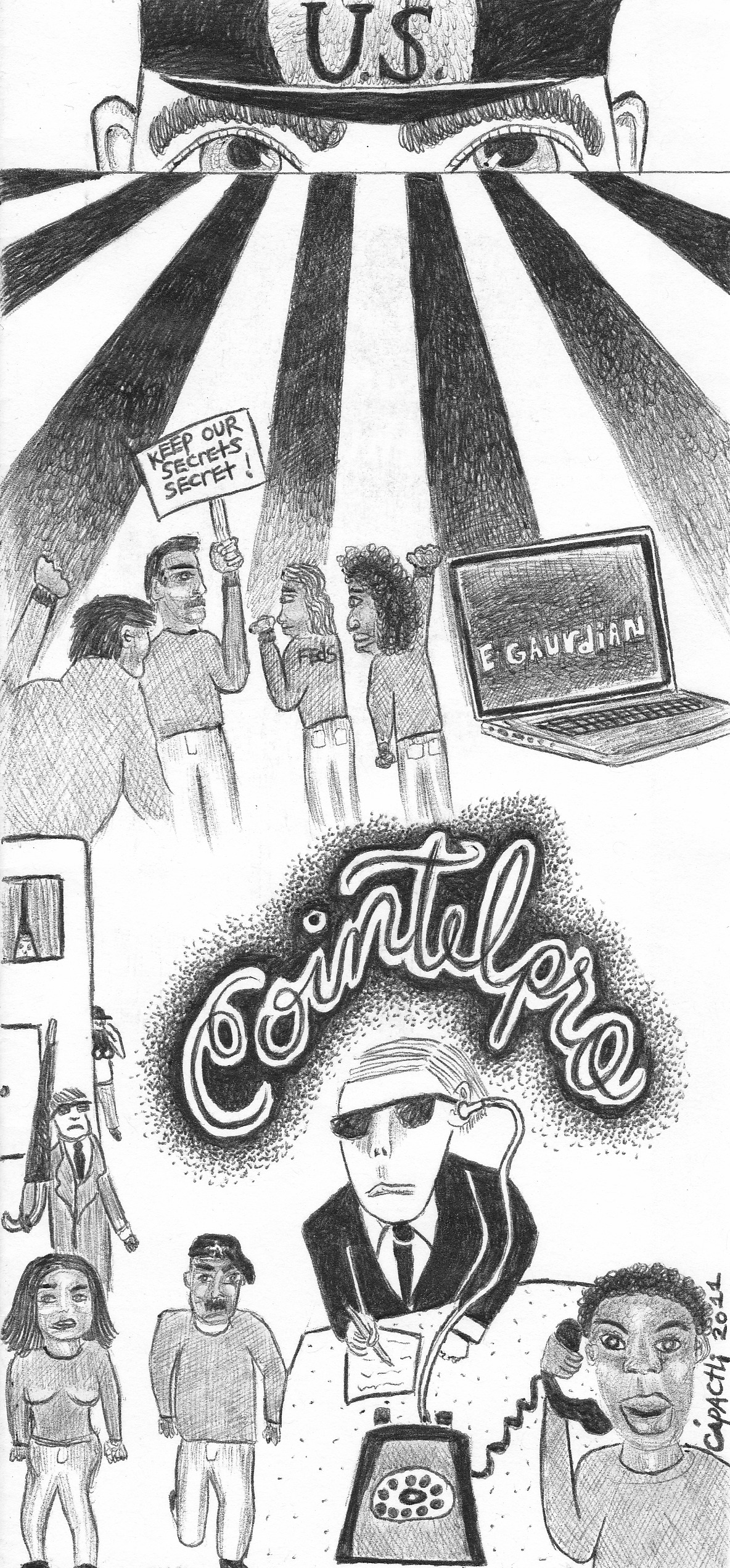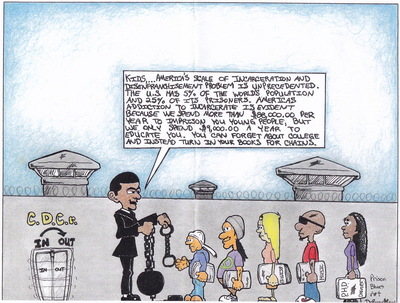I extend my greetings to you all and want to make a few observations
based upon questions posed by
Loco1
in ULK 23. It is quite true that we obtained the attention of
prisoncrats who have assumed that the continual promotion of division of
lumpen organizations will keep us at each other throats. Prisoncrats
have adapted and pursued new oppressive tactics as a result of the
intensive scrutiny that the shot across the bow of battleship CDCR
caused.
To retreat is not an option, as to do such only further emboldens
prisoncrats to erode civil and human rights of California prisoners,
actions which will be mimicked across the nation. We must use our
collective brains to adapt new tactics. In war many tactics are used.
You may be able to sneak up on an enemy once or twice but in due course
the opposition will counter with an ambush. So as master Sun Tzu stated
in The Art of War, “Those who win every battle are not really
skillful. Those who render others’ armies helpless without fighting are
the best of all!” And that’s what was done, embarrassing the prisoncrats
who were ill prepared to deal with it. It’s only a battle in a broader
war.
I am nobody’s leader or follower. My duties are to help teach
independent thought, which will ensure that an individual can and will
anticipate the likely reaction of prisoncrats and minimize the effect.
Everyone has seen the so-called increase of privileges, some of which
are still very elusive, since they mandate a year without a
disciplinary, which will never be possible for a true revolutionary or
resister to achieve. These privileges also encourage prisoners to lean
on their families and friends to help finance their imprisonment and
enrich prison profiteers who feed on the golden state’s teat.
The original hunger strike strategy clearly impacted prisoncrats. It
should provide a plethora of new tactical ideas. Consider that besides
the so-called security concerns over prisoners possessing cell phones,
the reality is that cell phones cut into prisoncrats’ fiscal resources.
The prison phone provider gives the CDCR a concession fee. This is why
prisoners’ phone privileges, canteen, packages and anything that the
CDCR receives a concession fee from, are generally not taken. The income
from canteen purchases pay the wages of state SEIU employees who are
canteen managers II, I, supervisors and workers in addition to profits
being diverted from prisoner welfare to custody welfare activities.
We should consider alternative strategies that hit them where it hurts
the most: in their pocketbook. Just like one can go without eating for a
week or three, people should be able to go without canteen for 3 to 6
months and empty trust accounts, which will result in more expense to
the CDCR. There are numerous ways that the CDCR sticks it to prisoners’
families and friends. So if, as Loco1 suggests, it is correct to
re-evaluate our actions, it is my opinion that the new strategy should
be a fiscal one.
I address this to all prisoners irrespective of your status, as status
is given by prisoncrats. Be you general population or sensitive needs,
if you choose to allow prisoncrats to manipulate and control you with
privileges, you are by proxy their collaborator. As such you cause as
much of the problem, rather than a solution.
I also want to point out that tactically and strategically it is
never
wise to call out numerous lumpen organizations as BORO/Loco1 did.
Such will likely have a negative impact, since those named will have to
deal with substantively more scrutiny. So while others may think that
ULK is a forum to send shout outs, to me the objective is to
try to encourage education and the capacity to think independently. The
CDCR benefits from dumbed-down prisoners, particularly those who do not
have their priorities in order.
Prisoncrats look to pacify all prisoners, particularly the segment that
is weakest. So it is on us to try to encourage self-esteem, self-worth,
self-sacrifice and self-deprivation, all of which builds character and
the ability to endure the picklesuits’ plots and conspiracies. The
preparation that is most important to any struggle is the will to
personally do something to encourage change. I believe that ideas and
strategies of the opposition should be examined, and then we can decide
on a course of action and systematically pass on the purpose and
reasoning, not as leaders to followers but as men and women in concerted
struggle.
The fact that there is no real accountability of prisoncrats and their
subordinates has again led to the introduction of Assembly Bill 1270 on
January 26, 2012 by Assembly Member Tom Ammiano to try to restore media
access to prisoners. Taking away media access gave prisoncrats control
over what’s spoon fed to the public. Independent media access is what
made it possible for the pacification privileges introduced in the 60s
and 70s, since there was a lot more transparency and prisoncrats were
exposed to more accountability. But since the imposition of media
restrictions on pre-arranged in-person interviews with prisoners, what
takes place in prison tends to be out-of-sight/out-of-mind.
I believe in a
United
Front, but we must recognize that the composition of that front is
varied. I prefer that we always seek to encourage education which brings
clarity and understanding to less knowledgeable comrades. I will say,
however that ignorance and stupidity is infectious. I guess I could be
equated with a silverback, only I do not take to leading. But I am not
adverse to the development of consciousness so maybe we should send
requests to the education department of all CDCR prisons asking for
“The
Rise of the Planet of the Apes” that Wiawimawo provided us with a
review of in August 2011, as it might help open up some minds to
revolutionary concepts.
Yes I’m all for a true United Front, where we all (Black, Brown, White,
Yellow, Red, Green, Blue or plaid) can stand together to regain our
civil and human rights, not confusing privileges with rights. We can
positively seek to cease all the senseless grudges that plague the
ethnic divisions and LOs. I do not believe in violence just for
amusement. My battle is not with prisoners, it’s with prisoncrats. Any
prisoner who sees me as a threat, I deem them an agent of the state.
“Think and not hate” is what your commentator in struggle relates.
MIM(Prisons) responds: First we want to agree with the criticism
of calling out LO members by name which we already responded to
elsewhere.
But we do not agree with this comrade’s abdication of leadership. The
movement has a strong need for leaders and pretending that all people
are equal in this way gives power over to the imperialists who have no
problem seizing leadership. Those who are more advanced, have more
education, or more will to struggle, must take up leadership positions
in educating and organizing others. We can’t afford to have these people
step back in the name of equality as that void will be filled by
reactionary leaders. The antidote to misleaders is better, more educated
leaders as well as a better more educated mass that can judge, choose
and reject would-be leaders. Ultimately we are working towards a
society, communism, where all people are equal and all can lead, but we
must deal with the current reality and uneven development of forces and
individuals. USW is an organization for leaders. A vanguard party is the
leader of the revolution. And the oppressed people desperately need more
leaders.






 Alabama
Alabama
 Alaska
Alaska
 Arizona
Arizona
 Arkansas
Arkansas
 Army Post
Army Post
 California
California
 Colorado
Colorado
 Connecticut
Connecticut
 Delaware
Delaware
 District of Columbia
District of Columbia
 Federal
Federal
 Florida
Florida
 Georgia
Georgia
 Guam
Guam
 Hawaii
Hawaii
 Idaho
Idaho
 Illinois
Illinois
 Indiana
Indiana
 Iowa
Iowa
 Kansas
Kansas
 Kentucky
Kentucky
 Louisiana
Louisiana
 Maine
Maine
 Maryland
Maryland
 Massachusetts
Massachusetts
 Michigan
Michigan
 Minnesota
Minnesota
 Mississippi
Mississippi
 Missouri
Missouri
 Montana
Montana
 Nebraska
Nebraska
 Nevada
Nevada
 New Hampshire
New Hampshire
 New Jersey
New Jersey
 New Mexico
New Mexico
 New York
New York
 North Carolina
North Carolina
 North Dakota
North Dakota
 Ohio
Ohio
 Oklahoma
Oklahoma
 Oregon
Oregon
 Pennsylvania
Pennsylvania
 Puerto Rico
Puerto Rico
 Rhode Island
Rhode Island
 South Carolina
South Carolina
 South Dakota
South Dakota
 Tennessee
Tennessee
 Texas
Texas
 Utah
Utah
 Vermont
Vermont
 Virginia
Virginia
 Washington
Washington
 West Virginia
West Virginia
 Wisconsin
Wisconsin
 Wyoming
Wyoming


